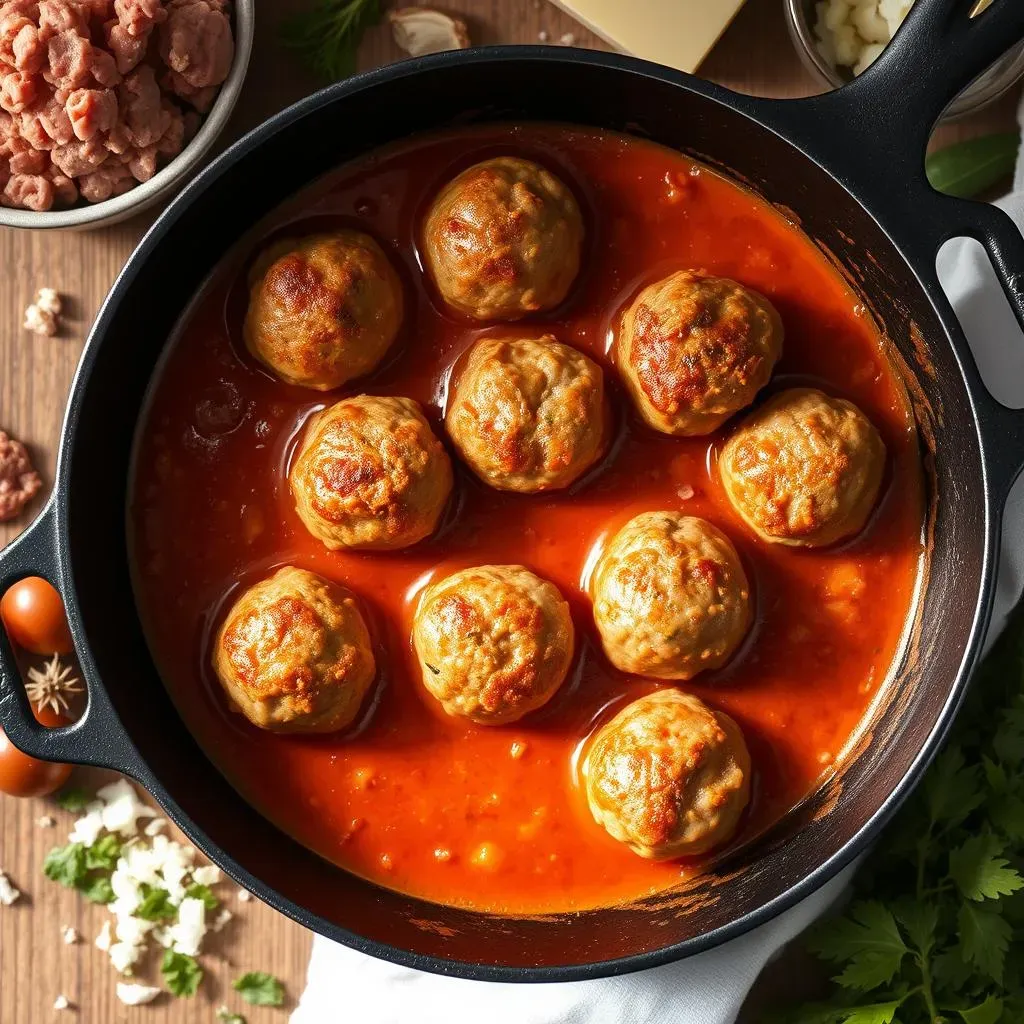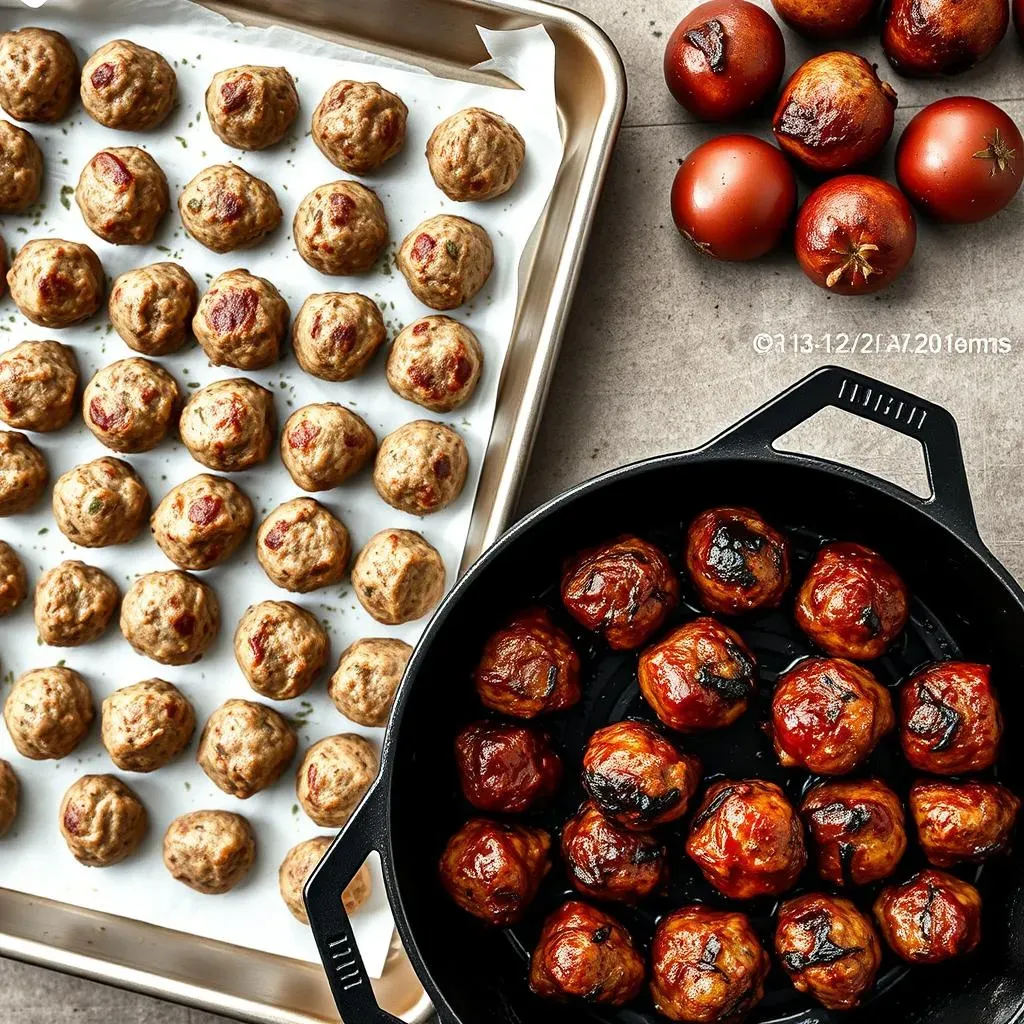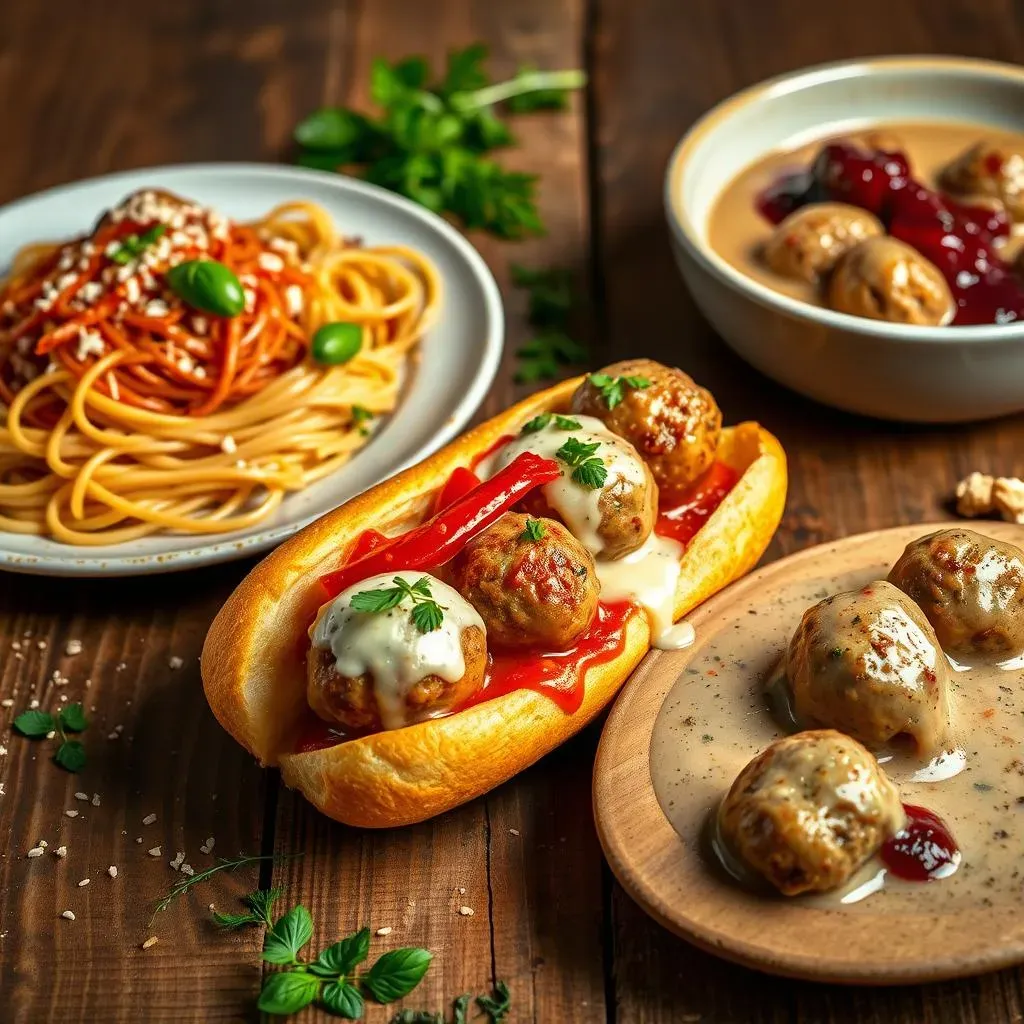Who doesn't love a plate piled high with tender, flavorful meatballs? Forget the store-bought versions – nothing beats the taste of homemade. This article dives deep into the world of homemade meatballs recipes, offering a comprehensive guide to creating the perfect meatball, every single time. We'll explore the essential ingredients that make a meatball truly exceptional, and share insider tips for achieving that coveted juicy texture. From mixing techniques to seasoning secrets, you'll learn how to customize your meatballs to suit any palate. Ready to ditch the jarred sauce and elevate your meatball game? We'll walk you through a simple, step-by-step recipe, perfect for both novice cooks and seasoned chefs. Discover the pros and cons of oven-baked versus pan-fried meatballs, and learn which method best suits your needs. Plus, we'll inspire you with creative serving suggestions, from classic spaghetti and meatballs to innovative meatball subs and appetizers. And because life is busy, we'll show you how to freeze and reheat your homemade meatballs for quick and easy weeknight meals. Get ready to embark on a meatball-making adventure that will transform your dinners forever!
The Secret to Perfect Homemade Meatballs: Ingredients & Tips

The Secret to Perfect Homemade Meatballs: Ingredients & Tips
Choosing the Right Ground Meat
The foundation of any great meatball is, of course, the meat. But not just any ground meat will do! Aim for a blend that's around 80% lean. This ensures enough fat to keep the meatballs moist and tender during cooking. Too lean, and you'll end up with dry, crumbly meatballs – nobody wants that! I personally love a mix of ground beef and pork. The beef provides that classic meatball flavor, while the pork adds richness and helps bind everything together. You can even throw in some ground veal for an extra layer of complexity. Experiment and find your perfect blend!
Also, consider the grind. A medium grind is generally ideal, as it provides a good balance of texture and binding ability. Avoid overly fine grinds, as they can result in a mushy meatball.
Binding Agents and Flavor Boosters
Beyond the meat, you need ingredients to bind everything together and amp up the flavor. Breadcrumbs are a must-have! They absorb excess moisture and help create a light and airy texture. I prefer using panko breadcrumbs, as they're coarser and provide a nice bite. Eggs are another essential binder, adding richness and helping the meatballs hold their shape. Don't forget the aromatics! Finely chopped onion and minced garlic are crucial for building a flavorful base. Fresh herbs, like parsley and oregano, add brightness and depth. And of course, a generous pinch of salt and pepper is essential for seasoning.
Parmesan cheese is another great addition that adds salty and savory notes. A touch of milk or cream can also help keep the meatballs moist. Don’t be afraid to experiment with different cheeses, herbs, and spices to create your signature meatball flavor!
Ingredient | Purpose | Recommendation |
|---|---|---|
Ground Meat (80% lean) | Base of the meatball | Beef/Pork blend |
Breadcrumbs (Panko) | Absorb moisture, light texture | Use coarse panko |
Egg | Binder | 1-2 per pound of meat |
Onion/Garlic | Aromatics | Finely chopped/minced |
Parmesan Cheese | Flavor | Freshly grated |
Secret Tips for Juicy Meatballs
Now for the real secrets to meatball perfection! First, don't overmix the meat mixture. Overmixing develops the gluten in the meat, resulting in tough meatballs. Mix just until everything is combined. Second, moisten your hands with water or olive oil before rolling the meatballs. This prevents the meat from sticking to your hands and helps create a smooth surface. Third, don't overcrowd the pan when cooking. Overcrowding lowers the temperature of the pan and causes the meatballs to steam instead of brown. Work in batches to ensure even browning.
Finally, and this is crucial, don't overcook the meatballs! Overcooked meatballs are dry and rubbery. Cook just until they are cooked through. A meat thermometer is your best friend here – aim for an internal temperature of 160°F (71°C).
StepbyStep Guide: Making the Best Homemade Meatballs

StepbyStep Guide: Making the Best Homemade Meatballs
Alright, let's get down to the nitty-gritty of making these delicious orbs of joy! First things first, gather all your ingredients. This isn't a race, but having everything prepped and ready will make the process smoother. In a large bowl, gently combine your ground meat, breadcrumbs, egg, grated Parmesan cheese, minced garlic, finely chopped onion, fresh herbs (if using), salt, and pepper. Remember what I said earlier – don't overmix! Use your hands to lightly combine everything until just incorporated. Overmixing leads to tough meatballs, and we want tender, juicy goodness.
Next, it's time to shape the meatballs. Moisten your hands with water or olive oil to prevent sticking. Grab a small amount of the meat mixture – I usually aim for about 1-1.5 inches in diameter, roughly the size of a golf ball. Gently roll the mixture between your palms to form a smooth, round meatball. Place the formed meatball on a baking sheet lined with parchment paper or a lightly oiled plate. Repeat until all the meat mixture is used up. Now, you're ready to cook!
There are two main ways to cook meatballs: baking and pan-frying. I'll cover both methods in more detail in the next section, but for now, let's assume you're baking them. Preheat your oven to 375°F (190°C). Arrange the meatballs on a baking sheet, making sure they're not overcrowded. Bake for 17-20 minutes, or until the meatballs are cooked through and no longer pink in the middle. A meat thermometer inserted into the center of a meatball should read 160°F (71°C).
If you're pan-frying, heat a tablespoon or two of olive oil in a large skillet over medium heat. Add the meatballs to the skillet, making sure not to overcrowd. Brown the meatballs on all sides, rotating them occasionally, until they're cooked through. This usually takes about 10-12 minutes. Once cooked, remove the meatballs from the skillet and place them on a plate lined with paper towels to drain any excess oil. Now, your homemade meatballs are ready to be enjoyed! Toss them with your favorite sauce, serve them over pasta, or use them in a meatball sub. The possibilities are endless!
Step | Description |
|---|---|
1. Combine Ingredients | Gently mix meat, breadcrumbs, egg, cheese, garlic, onion, herbs, salt, and pepper in a large bowl. |
2. Shape Meatballs | Moisten hands and roll meat mixture into 1-1.5 inch meatballs. |
3. Cook Meatballs | Bake at 375°F (190°C) for 17-20 minutes or pan-fry until browned and cooked through. |
4. Serve & Enjoy | Toss with sauce, serve over pasta, or use in sandwiches. |
OvenBaked vs. PanFried: Exploring Different Cooking Methods for Homemade Meatballs

OvenBaked vs. PanFried: Exploring Different Cooking Methods for Homemade Meatballs
Oven-Baked Meatballs: Hands-Off Convenience
let's talk about oven-baked meatballs! This method is all about convenience. You simply arrange your meatballs on a baking sheet and let the oven do its thing. No standing over a hot stove, no splattering oil – it's a set-it-and-forget-it kind of deal. Oven-baking is great for making large batches of meatballs, especially if you're feeding a crowd. The even heat of the oven ensures that the meatballs cook uniformly, resulting in a consistent texture throughout. Plus, you don't need to add any extra oil, making it a slightly healthier option compared to pan-frying.
However, oven-baked meatballs don't develop that same rich, browned crust that you get from pan-frying. They tend to be a bit softer and more tender, which can be a good thing or a bad thing, depending on your preference. I find that oven-baked meatballs are perfect for simmering in sauce, as they absorb the flavors beautifully without falling apart. Also, they're great for meal prepping, because when I bake a big batch on Sunday, I have meatballs to toss into lunches and dinners all week long.
Pan-Fried Meatballs: Sizzling Flavor & Texture
Now, let's move on to pan-fried meatballs. This method is all about flavor and texture. The direct heat of the skillet creates a beautiful, caramelized crust on the outside of the meatball, adding a depth of flavor that you just can't achieve with oven-baking. Pan-frying also gives you more control over the cooking process. You can adjust the heat as needed to ensure that the meatballs are browned evenly on all sides. It's a bit more hands-on than oven-baking, but the results are definitely worth the effort.
One thing to keep in mind is that pan-frying requires a bit of oil. You'll need to add enough oil to the skillet to prevent the meatballs from sticking and to help them brown properly. Also, pan-frying can be a bit messy, as the oil tends to splatter. But don't let that deter you! With a little practice, you'll be able to master the art of pan-frying meatballs like a pro. Pan-fried meatballs are amazing on their own, served as an appetizer with a dipping sauce. They also work well in sandwiches and pasta dishes.
Method | Pros | Cons | Best For |
|---|---|---|---|
Oven-Baking | Convenient, hands-off, even cooking, healthier | Less browning, softer texture | Large batches, simmering in sauce, meal prep |
Pan-Frying | Rich flavor, caramelized crust, more control | More hands-on, requires oil, can be messy | Appetizers, sandwiches, pasta dishes |
The Hybrid Approach: Best of Both Worlds?
Can't decide between oven-baking and pan-frying? Well, you don't have to! You can actually combine the two methods for the best of both worlds. Start by browning the meatballs in a skillet over medium-high heat. This will give them that delicious caramelized crust. Then, transfer the meatballs to a baking sheet and finish cooking them in the oven. This ensures that they're cooked through without drying out. It's a bit more work, but the results are truly exceptional. I've even used my air fryer to brown them, and then simmered them in sauce. The air fryer gives them a nice crust without all the oil.
This hybrid approach is perfect for those who want the convenience of oven-baking with the flavor and texture of pan-frying. It's also a great way to reduce the amount of oil you use. By browning the meatballs in a skillet first, you can use less oil than you would if you were pan-frying them completely. Give it a try and see what you think!
Serving Suggestions: Creative Ways to Enjoy Your Homemade Meatballs

Serving Suggestions: Creative Ways to Enjoy Your Homemade Meatballs
Classic Comfort: Meatballs & Pasta
Let's start with the obvious, because sometimes the classics are the best! Toss those juicy homemade meatballs with your favorite pasta and sauce for a comforting and satisfying meal. Spaghetti is the go-to, of course, but don't be afraid to experiment with other shapes. Penne, rigatoni, or even farfalle (bow-tie pasta) can be delicious. For the sauce, marinara is a classic choice, but pesto, Alfredo, or even a simple tomato sauce with herbs can also be amazing. I personally love a spicy arrabbiata sauce with my meatballs for an extra kick. Top with a generous sprinkle of Parmesan cheese and some fresh basil for the perfect finishing touch.
Want to take it to the next level? Try baking the meatballs and pasta together in a casserole dish for a cheesy, bubbly masterpiece. Layer cooked pasta, meatballs, sauce, and mozzarella cheese in a baking dish and bake until golden brown and bubbly. It's the ultimate comfort food!
Meatball Mania: Subs, Sliders, & Sandwiches
Beyond pasta, meatballs are incredibly versatile in sandwiches. A meatball sub is a true crowd-pleaser, perfect for a quick and easy lunch or dinner. Load up a toasted hoagie roll with meatballs, marinara sauce, and melted mozzarella cheese. You can also add some sautéed peppers and onions for extra flavor. Sliders are another fun option, perfect for parties or appetizers. Use small slider buns and top with a mini meatball, a dollop of sauce, and a sprinkle of cheese. For a twist, try using different types of bread, like brioche or pretzel rolls.
Don't limit yourself to just subs and sliders! Meatballs can also be used in other types of sandwiches. Try stuffing them into pita bread with hummus and veggies for a Mediterranean-inspired sandwich. Or, use them as a topping for an open-faced sandwich with mashed potatoes and gravy. The possibilities are endless!
Dish | Ingredients | Tips |
|---|---|---|
Meatball Sub | Hoagie roll, meatballs, marinara, mozzarella | Toast the roll for extra crunch. |
Meatball Sliders | Slider buns, mini meatballs, sauce, cheese | Use different types of cheese. |
Meatball Pita | Pita bread, meatballs, hummus, veggies | Add a drizzle of olive oil. |
Global Flavors: Meatballs Around the World
Who says meatballs have to be Italian? Get creative and explore different flavor profiles from around the world! Swedish meatballs are a classic, served in a creamy gravy with lingonberry jam. Asian-inspired meatballs can be made with soy sauce, ginger, and garlic, and served with rice noodles and stir-fried vegetables. Mexican-style meatballs can be simmered in a spicy tomato sauce with chipotle peppers and served with rice and beans. Indian-inspired meatballs can be made with curry powder and coconut milk, and served with naan bread.
Think about the flavors you love and how you can incorporate them into your meatballs. Use different types of meat, herbs, spices, and sauces to create a truly unique dish. Don't be afraid to experiment and have fun! The world is your meatball!
Freezing & Reheating: Mastering MakeAhead Homemade Meatballs Recipes

Freezing & Reheating: Mastering MakeAhead Homemade Meatballs Recipes
Freezing Like a Pro: Lock in That Flavor
so you've made a mountain of delicious homemade meatballs. Now what? Freezing is your best friend for meal prepping and those nights when you just can't be bothered to cook from scratch. But here's the secret: freeze them properly to maintain that amazing flavor and texture. The key is to prevent freezer burn. I like to flash freeze my meatballs first. Arrange the cooked and cooled meatballs in a single layer on a baking sheet lined with parchment paper. Pop them into the freezer for about an hour or two, until they're solid. This prevents them from sticking together when you transfer them to a freezer bag.
Once they're frozen solid, transfer the meatballs to a freezer-safe bag or container. Squeeze out as much air as possible to prevent freezer burn. Label the bag with the date and contents, so you know when you made them and what's inside. Frozen meatballs will last for up to 3 months in the freezer. I also like to freeze them in smaller portions, so I can thaw only what I need for a single meal. It's all about convenience, right?
Reheating Magic: From Freezer to Feast
So, you're ready to enjoy your make-ahead homemade meatballs. Now, how do you reheat them without turning them into rubbery hockey pucks? There are a few options. My favorite method is to reheat them in sauce. Simply add the frozen meatballs to your favorite sauce and simmer over low heat until they're heated through. This allows the meatballs to absorb the sauce and stay nice and moist. You can also reheat them in the oven. Place the frozen meatballs on a baking sheet and bake at 350°F (175°C) until they're heated through, about 15-20 minutes. If you're short on time, you can even microwave them, but be careful not to overcook them. Microwave in short intervals, stirring in between, until they're heated through.
No matter which method you choose, make sure the meatballs are heated to an internal temperature of 165°F (74°C) before serving. And remember, reheated meatballs are best enjoyed immediately. Don't refreeze them after thawing. With a little planning and these simple tips, you can enjoy delicious homemade meatballs any time you want, without spending hours in the kitchen!
Method | Instructions | Tips |
|---|---|---|
Simmer in Sauce | Add frozen meatballs to sauce and simmer over low heat. | Best for moist meatballs. |
Oven Reheating | Bake at 350°F (175°C) for 15-20 minutes. | Good for even heating. |
Microwave | Microwave in short intervals, stirring in between. | Quick, but easy to overcook. |
Conclusion: Your Meatball Mastery Awaits
So, there you have it – your ultimate guide to conquering the world of homemade meatballs. Armed with these recipes, tips, and tricks, you're well on your way to creating meatball masterpieces that will impress your family and friends. Whether you prefer classic Italian flavors or crave something a little more adventurous, remember that the best meatballs are the ones made with love (and maybe a secret ingredient or two). Don't be afraid to experiment, get creative with your seasonings and sauces, and most importantly, have fun in the kitchen. Now go forth and create some meatball magic!